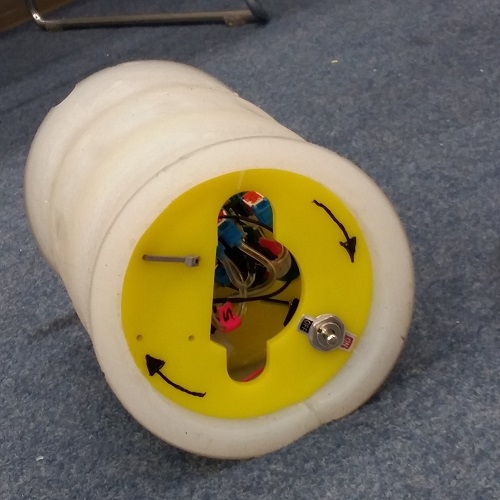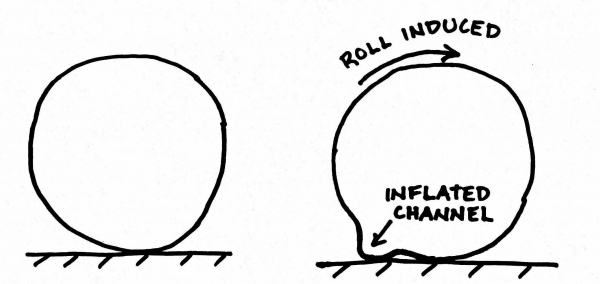|
|
The Soft Wheel Robot is a project designed and built by a team of two undergraduate students and one graduate student from Cornell University, advised by professors Hadass Kress-Gazit and Robert Shepard. The goal of the project was to make an untethered, cylindrical soft robot, which is propelled in a rolling motion by pneumatically actuated channels. The robot is designed to be capable of rolling forward, backward, and turning to either side. All components, including a pneumatic source, are contained inside the soft wheel so that it can move freely without being connected to any external equipment. After four months of of designing, prototyping, and testing, they developed the following prototype:

Final Prototype of Robot
The preliminary design section details the steps they took to make this final prototype. Before they started prototyping, the team did extensive research on any existing designs for a pneumatically driven rolling robot. They discovered a cylindrical rolling robot used in the Distributed Robotics Laboratory at MIT, with a published speed of 1.2 ft/min. While similar in nature due to its cylindrical shape, this robot does not utilize the full potential of a rolling wheel. Its actuators are positioned along the outer perimeter, so its profile is not completely round. Actuators tip it over in short rolls, but it is stopped when it hits the next non-round actuator. The team envisioned a wheel which would be completely circular in profile, with channels embedded such that when actuated, they cause the cylinder to roll, but in their relaxed state, they do not stop the wheel from rolling freely rolling. By conserving the momentum gained from each channel actuation, the students believed they could build a robot that will achieve much higher speeds. They also wanted the robot to have the added capability of turning.

Initial Ideas for Rolling Motion
The team plans on continuing their work this coming school year (2015-16) to work on developing a second gait. If the robot was composed of a hollow cylindrical body, they thought that could be sealed on either end and then could be held in a cylindrical shape by pressurizing the central chamber. Then, in its deflated state, it would resemble a tank tread, shorter in height, which could be moved forward by actuating the same channels but in a different pattern to cause a worm-like undulating motion. This second gait might be useful for going under low-hanging structures.
Initial Ideas for Undulating Motion
| Some of the information contained in this web site includes intellectual property covered by both issued and pending patent applications. It is intended solely for research, educational and scholarly purposes by not-for-profit research organizations. If you have interest in specific technologies for commercial applications, please contact us here. |

